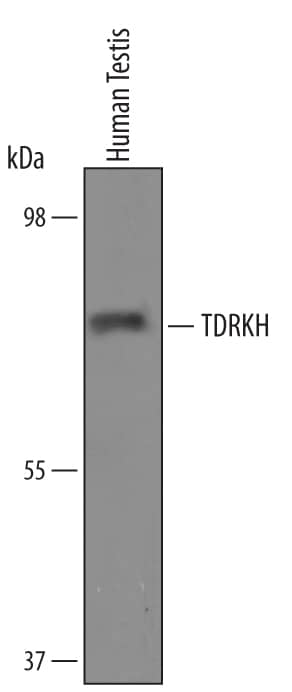Human TDRKH Antibody
R&D Systems, part of Bio-Techne | Catalog # AF6286

Key Product Details
Species Reactivity
Applications
Label
Antibody Source
Product Specifications
Immunogen
His206-Leu561
Accession # Q9Y2W6
Specificity
Clonality
Host
Isotype
Scientific Data Images for Human TDRKH Antibody
Detection of Human TDRKH by Western Blot.
Western blot shows lysates of human testis tissue. PVDF Membrane was probed with 1 µg/mL of Human TDRKH Antigen Affinity-purified Polyclonal Antibody (Catalog # AF6286) followed by HRP-conjugated Anti-Sheep IgG Secondary Antibody (Catalog # HAF016). A specific band was detected for TDRKH at approximately 70 kDa (as indicated). This experiment was conducted under reducing conditions and using Immunoblot Buffer Group 8.TDRKH in Mouse Testis.
TDRKH was detected in immersion fixed frozen sections of adult mouse testis using Human TDRKH Affinity-purified Polyclonal Antibody (Catalog # AF6286) at 10 µg/mL overnight at 4 °C. Tissue was stained using the NorthernLights™ 493-conjugated Anti-Sheep IgG Secondary Antibody (green; Catalog # NL012) and counterstained with DAPI (blue). Specific staining was localized to germ cells. View our protocol for Fluorescent IHC Staining of Frozen Tissue Sections.Applications for Human TDRKH Antibody
Immunohistochemistry
Sample: Immersion fixed frozen sections of adult mouse testis
Western Blot
Sample: Human testis tissue
Formulation, Preparation, and Storage
Purification
Reconstitution
Formulation
Shipping
Stability & Storage
- 12 months from date of receipt, -20 to -70 °C as supplied.
- 1 month, 2 to 8 °C under sterile conditions after reconstitution.
- 6 months, -20 to -70 °C under sterile conditions after reconstitution.
Background: TDRKH
TDRKH (Tudor domain and KH domain containing protein; also TDRD2) is a 70 kDa member of the Tudor family of proteins. It is expressed in developing spermatogonia and meiotic primary spermatocytes, but not embryonic stem cells. TDRKH forms part of an RNA-silencing complex that safeguards the germ cell genome. Through its 60 amino acid (aa) Tudor domain, it binds methylated PIWI (P-element-induced wimpy testis) protein and serves to position PIWI for non-coding RNA binding. Human TDRKH is 606 aa in length. It contains two RNA recognition KH domains (aa 52-115 and 124-190), and one methyl-binding Tudor domain (aa 353-412). There are four potential splice forms. Three possess a shared deletion of aa 562-606, with two of these also showing a unique deletion of aa 108-152 and 76-79, respectively; a fourth shows a two aa substitution for aa 559-606. Over aa 206-561, human TDRKH shares 87% aa identity with mouse TDRKH.
Long Name
Alternate Names
Gene Symbol
UniProt
Additional TDRKH Products
Product Documents for Human TDRKH Antibody
Product Specific Notices for Human TDRKH Antibody
For research use only

